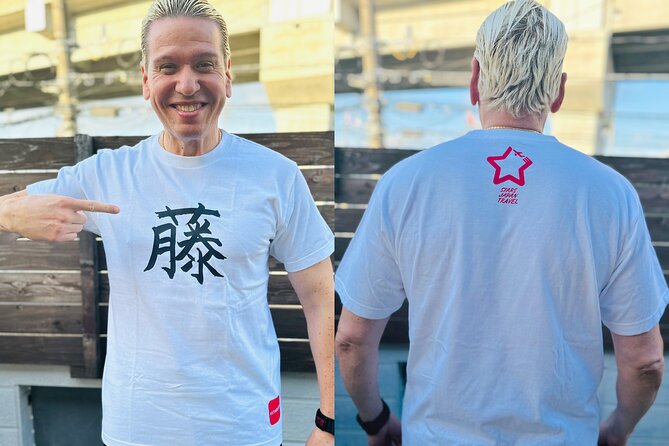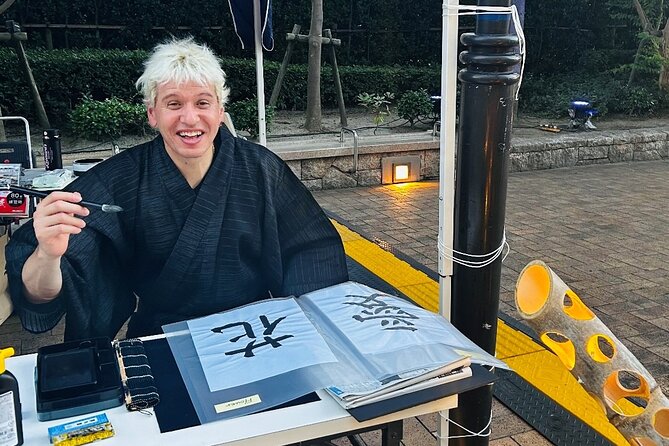Japanese Calligraphy Experience
Set out on a transformative journey through the mesmerizing world of Japanese calligraphy, where every brushstroke holds the power to captivate the soul.
The allure of this ancient art form lies in its ability to transcend mere ink on paper, conveying emotions and stories with each elegantly crafted character.
As participants enjoy the graceful movements guided by experienced instructors, they begin to unravel the profound cultural significance embedded within each stroke.
Stay tuned to discover how this immersive experience can awaken a newfound appreciation for the artistry and discipline that define Japanese calligraphy.
Key Points

- Japanese calligraphy offers mindfulness, culture, and artistic expression.
- Mastery demands precise brush control, ink understanding, and attention to detail.
- Essential tools include brushes, sumi ink, washi paper, and seals for authenticity.
- Each character formed reflects skill, emotion, and intention, adding depth to the artwork.
Overview
Set out on a captivating journey into the world of Japanese calligraphy with a hands-on experience that delves into the art’s rich history and cultural significance.
This culture allows participants to express themselves artistically through the mindful practice of calligraphy. It’s a creative exploration where strokes convey deeper meanings and emotions. Engaging in this art form goes beyond just writing characters; it embodies a connection to tradition and aesthetics.
Through Japanese calligraphy, you can experience the beauty of simplicity and the power of expression. Each stroke becomes a reflection of one’s inner thoughts and feelings, making this experience not just about writing but also about self-discovery and artistic growth.
History

In tracing the roots of Japanese calligraphy, one uncovers a narrative woven deeply into the cultural fabric of Japan, revealing a storied past of artistic evolution and societal influence.
-
Centuries-old Tradition: Japanese calligraphy, known as ‘Shodo,’ has been practiced for over 2,000 years, deeply ingrained in Japanese culture and spirituality.
-
Influence of Zen Buddhism: The art form’s development was significantly influenced by Zen Buddhism, emphasizing simplicity, precision, and mindfulness in every brushstroke.
-
Cultural Significance: Japanese calligraphy isn’t just about writing characters but also about expressing emotions, capturing the essence of nature, and fostering personal growth through disciplined practice. Its cultural significance extends beyond mere words, embodying the soul of Japan’s artistic heritage.
Benefits
Delving into the world of Japanese calligraphy unveils a myriad of benefits that extend beyond mere artistic expression. Engaging in this art form can significantly contribute to one’s mental wellness by promoting mindfulness and focus. The practice of calligraphy serves as a gateway to culture, allowing individuals to connect with Japan’s rich heritage and traditions. Through strokes and characters, participants can express their emotions and thoughts, enhancing their artistic expression. The rhythmic movements required in calligraphy also serve as a mindfulness practice, helping individuals find peace and tranquility in the present moment.
| Benefits of Japanese Calligraphy | |
|---|---|
| Mental Wellness | Cultural Immersion |
| Artistic Expression | Mindfulness Practice |
Techniques
Exploring the art of Japanese calligraphy involves mastering a variety of precise techniques that bring strokes and characters to life on paper. To create stunning calligraphy pieces, practitioners focus on two key elements:
-
Brush Control: Achieving mastery in calligraphy requires precise control over the brush. Practitioners must learn how to manipulate the brush to create thick and thin lines, control the flow of ink, and apply varying pressure to produce different effects.
-
Ink Types: The type of ink used in Japanese calligraphy significantly impacts the final result. Various ink types offer different consistencies and finishes, influencing the overall appearance of the characters. Understanding the characteristics of different inks helps artists choose the most suitable one for their desired outcome.
Materials
Discover the essential materials integral to creating captivating Japanese calligraphy pieces that embody the art’s rich tradition and aesthetic beauty.
Japanese brushes, known as ‘fude,’ play a crucial role in calligraphy, with different types providing various strokes and effects. The quality of ink used is also paramount, as it affects the richness and depth of the characters. High-quality sumi ink, traditionally made from soot and glue, is favored for its intense black hue and smooth flow on paper.
The combination of the right brush and ink quality can elevate a calligrapher’s work, adding nuances and elegance to each stroke. Embracing these materials not only enhances the artistic process but also connects practitioners to the centuries-old heritage of Japanese calligraphy.
Process
Moving from the realm of materials essential to Japanese calligraphy, the process unfolds as a dynamic journey of ink meeting paper to create striking characters that embody the art’s profound cultural significance and artistic finesse.
-
Cultural Immersion: Engaging in Japanese calligraphy is a profound way to take in the rich cultural heritage of Japan.
-
Mindfulness Practice: The careful strokes and focused concentration required in calligraphy serve as a mindfulness practice, allowing participants to be fully present in the moment.
-
Creative Outlet: Japanese calligraphy provides a creative outlet for individuals to express themselves artistically through the elegant and precise movements required to form each character.
Tips
For optimal success in Japanese calligraphy, beginners should focus on maintaining a steady hand and controlling brush pressure to achieve clean and elegant strokes. Practice techniques play a crucial role in honing one’s skills. Start by practicing basic strokes repeatedly to build muscle memory and improve precision.
Understanding the cultural significance behind each character can also enhance the depth of your calligraphy. Explore the meanings behind different symbols and characters to infuse your writing with intention and respect for tradition.
Embrace the meditative aspect of calligraphy, allowing yourself to focus solely on the present moment and the movement of your brush. By combining practice techniques with an appreciation for the art’s cultural roots, beginners can embark on a fulfilling journey into the world of Japanese calligraphy.
Last Words
In reflecting on the journey through Japanese calligraphy, one can truly appreciate the discipline, artistry, and cultural richness intertwined in this ancient practice. Engaging with this art form goes beyond strokes on paper; it fosters cultural enrichment as individuals enjoy the traditions and history of Japan.
On top of that, the act of creating intricate characters allows for artistic expression, where emotions and meanings are conveyed through each brush movement. Through this practice, individuals often experience personal growth as they master new techniques and gain confidence in their abilities.
Ultimately, Japanese calligraphy serves as a mindful practice, encouraging focus and presence in each moment. The beauty of calligraphy lies not only in the final product but in the transformative journey it offers to those who partake.
Common questions
Are There Any Age Restrictions for Participating in the Japanese Calligraphy Experience?
There are no age restrictions for participating in the activity, and parental supervision may be required. The experience is designed to accommodate most travelers, ensuring a memorable and inclusive opportunity for all participants.
Is There a Dress Code or Recommended Attire for the Calligraphy Session?
For the calligraphy session, comfortable attire is recommended. Casual clothing is suitable for this activity. The focus should be on ease of movement and relaxation. Dress code guidelines encourage participants to wear what feels best for an enjoyable experience.
Can Participants Take Home Their Calligraphy Creations After the Experience?
Participants can take home their calligraphy creations after the experience. They have various display options to showcase their work. The session provides insights into calligraphy techniques and practice tips, enhancing the overall learning and creative experience.
Are There Any Specific Cultural Etiquettes or Customs to Be Aware of During the Calligraphy Session?
When engaging in cultural customs, etiquette awareness is key. Respect traditions, observe behaviors, and follow guidelines to honor the heritage. Understanding these nuances enhances the experience and fosters a deeper connection with the culture.
Is It Possible to Request a Personalized or Custom Calligraphy Piece During the Experience?
Yes, it’s possible to request custom calligraphy pieces during the experience. Participants can explore their artistic freedom by making personalized requests. This adds a unique touch to the session, allowing for creative expression and individuality.
Last Words
Enjoy the art of Japanese calligraphy, where history and tradition come alive through each brush stroke. Experience the meditative benefits and cultural significance of this ancient practice, guided by skilled instructors who bring the beauty of characters to life.
Whether you’re a novice or a seasoned artist, the Japanese Calligraphy Experience promises to ignite your passion for art and deepen your appreciation for the rich artistic legacy of Japan.